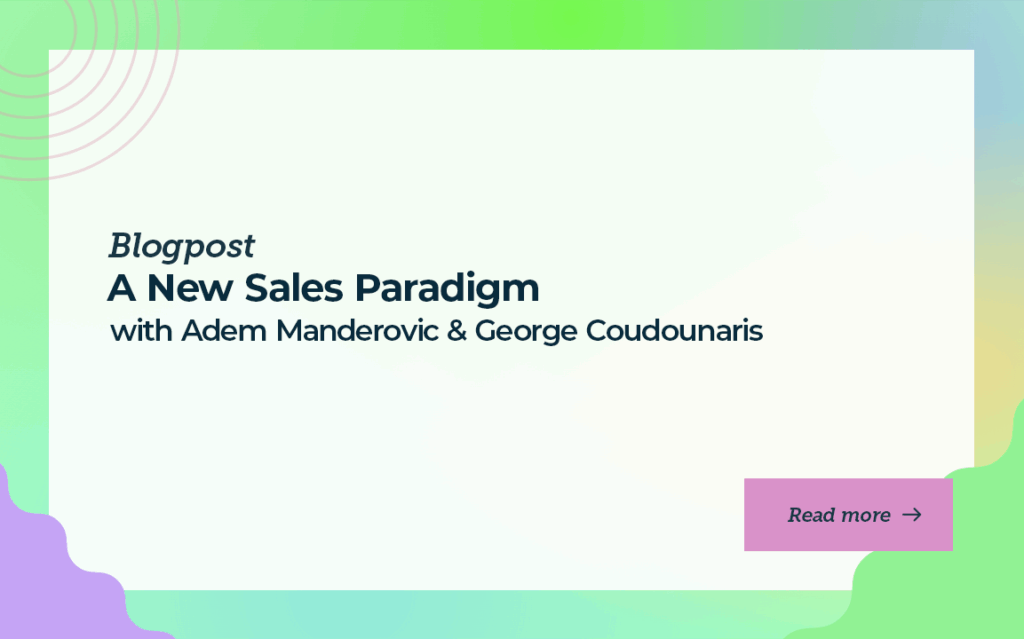A New Sales Paradigm with Adem Manderovic & George Coudounaris

Big-company playbooks break in small markets, they burn finite lists, rush demos, and optimize dashboards over learning.
On the Predictable Revenue Podcast, Collin Stewart dug into what works instead with CRO School co-founders George Coudounaris and Adem Manderovic: a closed-circuit, relationship-first motion.
This post distills those ideas into a loop you can ship now, validate before scaling, turn discovery into buyer language, and align sales and marketing with one weekly change.
Outbound becomes a market-intelligence engine, not a meeting factory: segment tightly → run real discovery → adjust message/channel → re-engage with relevance, repeat.
Why Big-Company Playbooks Break in Small Markets
Most “proven” playbooks were built for massive TAMs, big brand gravity, and wide funnels. If your market is tight or early, those tactics ignore context and segment size.
Borrowed tactics ignore context.
Sequencing meant for 50k accounts collapses when you’ve got 500. Spray-and-pray burns through the whole addressable list in a quarter. Generic messaging that worked with high intent falls flat when your buyers don’t yet recognize the problem.
Pipeline goals force shortcuts, not learning.
Monthly meeting targets push reps to optimize for booked calls, but they don’t understand. The result: premature demos, rushed qualification, and no time to validate whether the pain is real. You get pipeline inflation, not traction. Remember: “Market validation is key to success.”
The outcomes are predictable.
- Disjointed SDR motions: activity spikes with no compounding insight.
- Superficial discovery: BANT boxes checked, zero language you can reuse in content or follow-ups.
- Low trust: buyers feel processed, not helped, so they ghost.
Founder checklist (fix the fit):
- Right-size your motion: if you have <1,000 accounts, treat every touch like research + relationship building.
- Redefine the weekly KPI: fewer net-new, more “validated pains logged” and “language captured.”
- Collapse handoffs: SDR/AE/Marketing meet weekly to review patterns and ship one change (subject line, opener, offer) based on what you heard.
Traditional playbooks often fail in smaller markets because they skip validation and relationships, the very inputs you need to make any motion work.
Closed-Circuit Selling (What It Is & Why It Works)
Definition: A relationship-first, feedback-tight motion where every touch (call, email, demo, post) feeds what you target, what you say, and what you offer, immediately. It replaces linear “spray → pray → report” with a loop that learns fast and compounds.
Why it works (in small/early markets):
- Validation before volume. You confirm the problem and offer before scaling the activity, so you don’t burn a finite list.
- Signal density. Conversations yield language, objections, triggers, usable data you can ship into messaging within a week.
- Trust as an asset. Relationship building isn’t fluff. It’s how you earn more context, referrals, and higher reply quality over time.
The Closed Circuit: 5 Steps
1- Segment tightly:
- Pick one micro-segment (industry × role × trigger). Smaller = clearer patterns.
- Output: 50–200 named accounts with a shared moment (e.g., “recent SOC2 audit”).
2- Run deep discovery
- Lead with curiosity, not a deck. Map pains, workflows, adjacent tools, and success criteria.
- Output: Verbatims, themes, and 2–3 hypothesis statements you can test
3- Validate problem/offer fit
- Float a simple, specific promise or micro-offer (audit, teardown, pilot).
- Output: Yes/No signals on the problem and willingness to try the next step.
4- Adjust messaging & channel
- Refactor subject lines, openers, talk tracks, and choose the channel buyers actually answer (often LinkedIn/intro > cold call > email, varies by segment).
- Output: A refreshed sequence and 1–2 new assets that mirror the words you heard.
5- Re-engage with higher relevance
- Circle back with the updated message or offer; reference their language and context.
- Output: Higher reply rates, warmer intros, and cleaner next steps.
Operating cadence: Run the loop weekly. One change is shipped every Friday (message, asset, offer, or list). Measure learning speed (validated pains/week), reply quality (% that reference your thesis), and discovery→next-step conversion. When signals strengthen, then scale.
Discovery > Demo: Qualifying Through Understanding
Treat discovery like market research with a quota. Your job isn’t to “get to the deck”. It’s to learn what matters, in the buyer’s words, and decide if there’s a real problem worth solving now.
Make discovery do real work
- Goal shift: From “book demo” to “verify problem + impact + urgency.”
- Evidence over anecdotes: Capture verbatim, not vibes.
- Decision test: If you can’t summarize the buyer’s world better than they can, you’re not ready to propose.
Ask for unmet needs, not checkbox data
BANT questions fill CRM fields but miss context. Go deeper: workflows, workarounds, failure points, trigger events, success metrics. You’re mapping how pain shows up—so your offer can remove it.
Catalog what you hear and close the loop
- Themes: repeating pains, jobs-to-be-done, blockers.
- Language: exact phrases the market uses (headlines and subject lines write themselves).
- Triggers: events that spike urgency (new tool rollout, audit, headcount change).
Ship this into marketing weekly to update ICP notes, messaging, and assets. Alignment is a cadence, publish the learning.
Sidebar: 7 discovery prompts that surface real pains
- “Walk me through the last time this went wrong. What broke first?”
- “What do you do today to work around it? Who’s involved?”
- “When doesn’t this hurt? What’s different in those cases?”
- “What did you try already, and why didn’t it stick?”
- “If this were fixed next quarter, what would you start doing that you can’t do now?”
- “What changed recently that made this a priority (or not)?”
- “On a bad month, what metric takes the hit, and by how much?”
Operationalize it
- Before call: hypothesis (problem + trigger), 3 must-learn questions.
- During: Tag theme/trigger live.
- After (5 min): log “problem summary, impact, language, next step.”
- Metric: discovery → clear next step rate; % calls with a new validated trigger; # of reusable phrases added to the catalog per week.
When discovery is rigorous, demos become confirmations, not auditions, and outbound turns into your highest-signal research engine.
Demand Gen Beyond Dashboards
Dashboards don’t create demand. Conversations do. Use the numbers to confirm what’s working, not to decide what to do. Talk to the market, log patterns, and ship changes weekly.
Turn discovery into demand
- Mine your call notes for repeat pains, phrases, and trigger events.
- Build content and offers that mirror those exact words.
- Measure by reply quality and next steps, not just vanity reach.
Ship content that sounds like your buyers
Generic ebooks get ignored. Posts, emails, and short videos that quote your buyers’ language get replies. If you heard “the SOC2 audit derailed onboarding,” make that the headline, not “10 Tips for Compliance.”
Run small, high-signal experiments (not bloated campaigns)
- Narrow audience (50–200 accounts).
- One hypothesis per test.
- One clear call to action.
- 5–7 day window to judge signal.
- Kill fast. Double down where you see pull.
Tactic Trio
1) Message tests (fast & focused)
- Format: A/B subject lines + first 2 sentences based on one pain theme.
- Example:
- A: “Your SOC2 slowed onboarding?”
- B: “Onboarding halted by audits—quick fix?”
- Measure: % replies referencing “audit/slowdown,” not just opens.
2) Micro-CTAs (reduce friction)
- Goal: Make the next step tiny and specific.
- Examples:
- “Want the 5-line snippet we used to cut audit prep time?”
- “I can send a 2-slide teardown of your onboarding, yes/no?”
- “Open to a 15-min pilot scope to test with 1 team next sprint?”
- Measure: CTA acceptance rate and CTA → meeting conversion.
3) Founder-led outreach (trust accelerant)
- Why: Early markets buy context. Founders compress trust and learning cycles.
- Template (short + specific):
- “Saw you’re rolling out SOC2 while hiring 3 CSMs. A common failure point is onboarding stalls. We built a 2-step checklist that cut prep time by 40% at a peer. Want the checklist or a 10-minute run-through?”
- Measure: Warm intros earned, problem-confirming replies, and pilots started.
Operating rhythm
- Monday: pick one theme, one micro-offer, one segment.
- Midweek: run message test + micro-CTA + founder touches.
- Friday: review signal (reply quality, problem confirmations, next steps), ship one content/update (post, email, or asset) that mirrors what worked.
What to ignore
- Impressions without replies.
- MQLs without discovery.
- Dashboards that look great but don’t change what you say next week are ineffective.
Demand shows up as language that matches your thesis + momentum to the next step. Everything else is noise.
Sales/Marketing Alignment That Actually Ships
Alignment isn’t a slogan. It’s a weekly shipping cadence. Provide both teams with the same definitions, inputs, and a single narrative to execute from first touch to close.
Share the same definitions
- ICP tiers: Tier 1 (must-win: fits core problem + trigger present), Tier 2 (adjacent: problem present, weaker trigger), Tier 3 (watchlist: learning only).
- Problems: Name 3–5 pains in the buyer’s words (from discovery notes).
- Success criteria: The business outcome a buyer cares about (e.g., “cut onboarding stalls by 30% before Q2 audit”). Tie each criterion to a metric and a proof point.
Run the weekly “catalog” review
- Look at what you heard (verbatims, themes, triggers), not just what you sent.
- Decide which changes to make next: list, message, offer, or channel, with at least one change.
- Document micro-decisions so the next week builds on the last (compounding insight).
One operating narrative, end-to-end
- Top-of-funnel: Problem thesis + trigger + promise (the line your SDRs and content both use).
- Mid-funnel: Talk tracks and assets that mirror discovery language.
- Bottom-of-funnel: Case proof framed to the same problem/trigger, no new story at proposal time. Same spine, different depth at each stage.
The Future of Outbound: Context Wins
Outbound isn’t dead. Contextless outbound is. Calls and emails still land when they’re insight-led and relationship-first.
Why it works now
- Segmentation first, sequence second. Sequence quality is capped by the precision of your segment. Tight segment = shared triggers = messages that feel native.
- Discovery feeds craft. The best lines come straight from buyer verbatims. If your opener mirrors how they describe the pain, replies jump.
- Relationships compound signal. Warm intros, quick favors, and follow-ups with value (not pressure) turn each touch into more context.
Outbound = market intelligence engine
Stop treating outbound as a meeting factory. Use it to learn: Which triggers create urgency? Which promises get belief? Which roles co-own the problem? Feed those answers into targeting, content, and the offer.
Operate like this
- List: 50–150 accounts sharing a clear trigger (e.g., “post-audit onboarding delays”).
- Message: 1 problem thesis in buyer language; 2 variants max.
- Offer: Micro-CTA tied to the trigger (audit checklist, 2-slide teardown, 10-min pilot scope).
- Loop: Log replies by theme; ship one change every Friday.
Micro-sequence (context-led)
- Email 1: “Your SOC2 wrapped, seeing onboarding stalls right after the audit. We built a 2-step checklist that cut prep time by 40% at a peer. Want it?”
- Bump (2–3 days): “Happy to send the checklist or a 2-slide teardown. Which is useful?”
- Call: “Not selling, sanity-checking where the stall shows up first. Is it a security review or provisioning?”
- Social touch: Comment on their post by referencing the exact trigger and share one line of the checklist.
Metrics that matter
- Reply quality: % replies that reference your stated problem/trigger.
- Insight yield: new validated pains or triggers per 10 touches.
- Momentum: discovery → next step rate (pilot/teardown accepted).
- Compounding: warm intros/referrals per 20 conversations.
Context transforms an interruption into help. Lead with what you know about their moment, prove it with a tiny, relevant offer, and keep the loop tight.
Conclusion
In small markets, context beats volume. Ditch borrowed playbooks.
Run a closed circuit: validate before you scale, turn discovery into buyer language, ship one change a week, and re-engage with relevance. When you do, outbound stops interrupting and begin to inform everything you build and say.
Level up your GTM loop! Join CRO School, grab their newsletter, or book a workshop.
→ Explore CRO School • Follow George • Follow Adem.
Keep learning from operators who ship.
→ Subscribe to the Predictable Revenue Podcast • Get the newsletter • Connect with Collin.
NO TIME TO READ?



